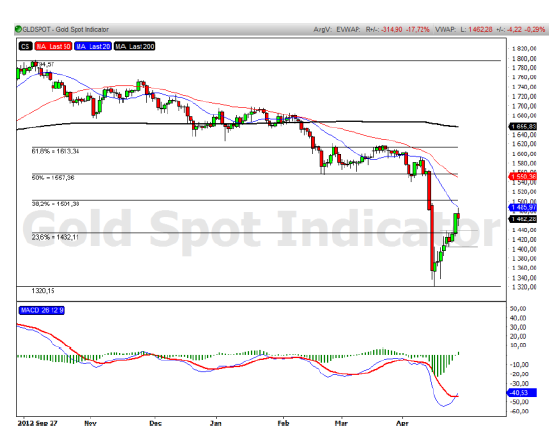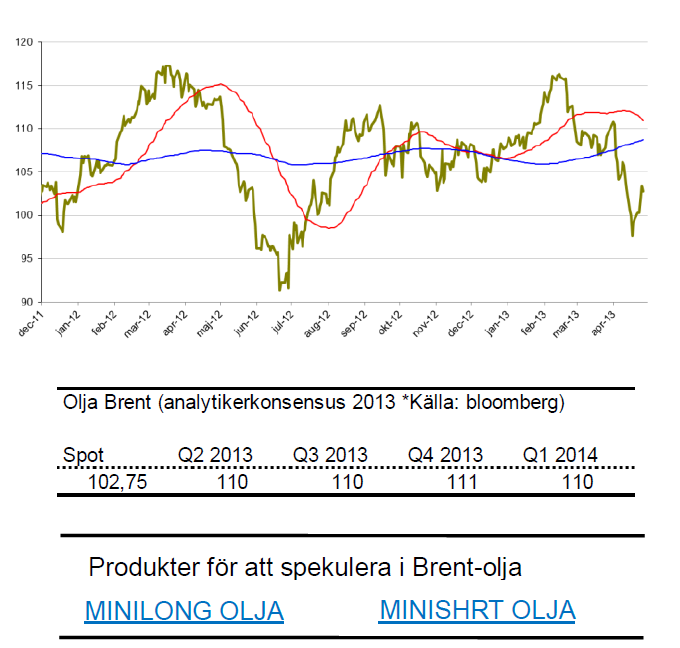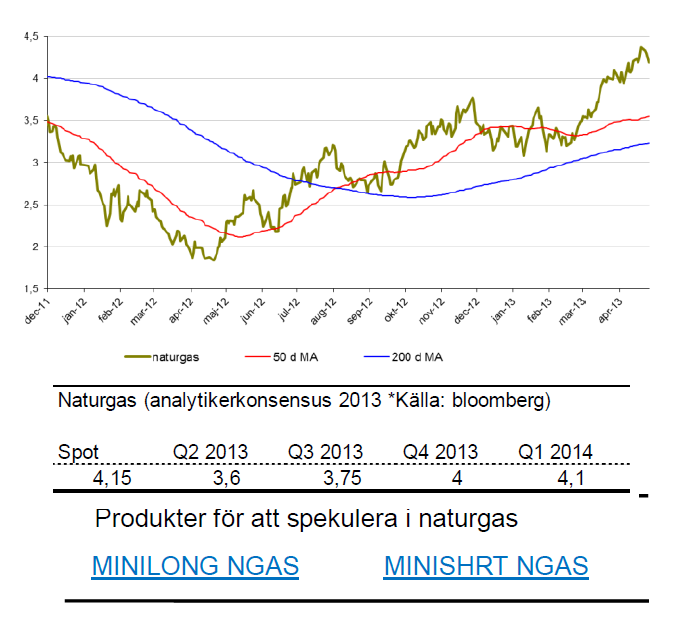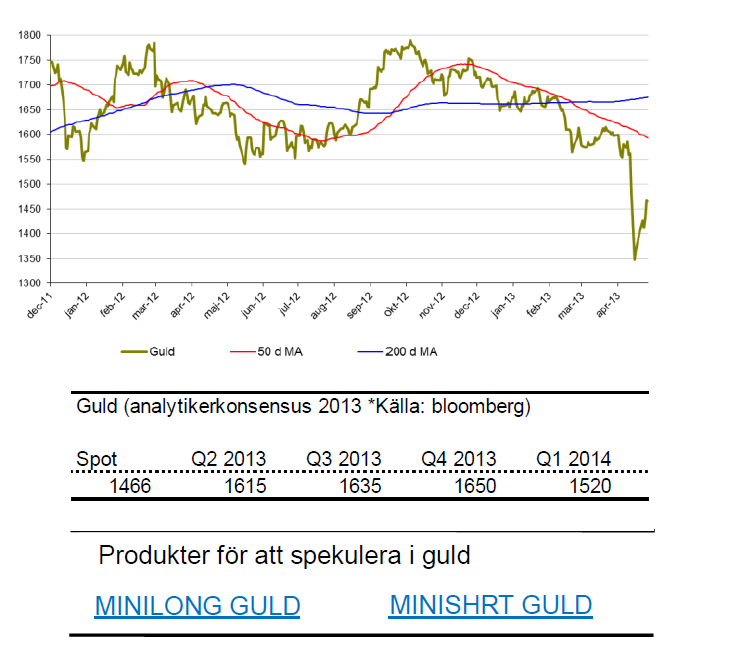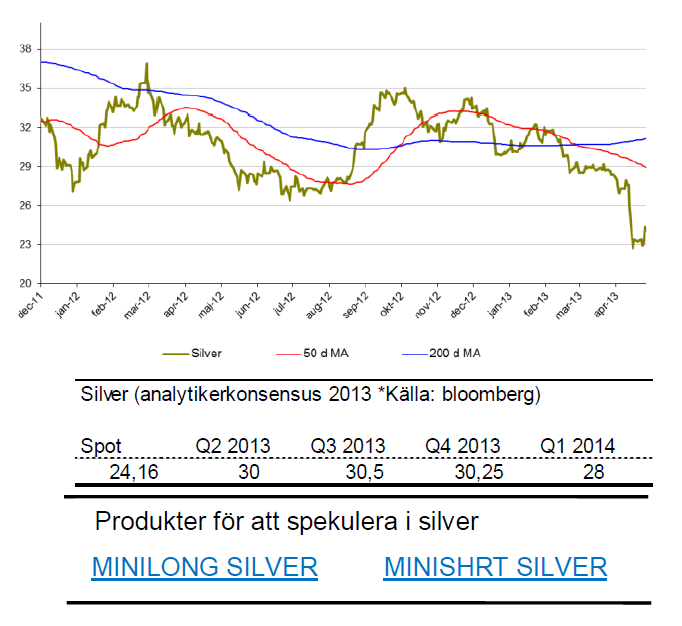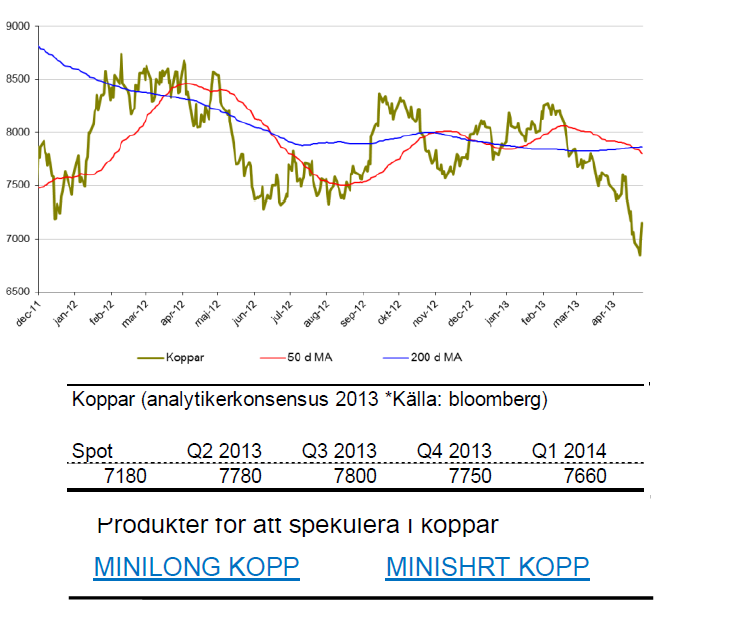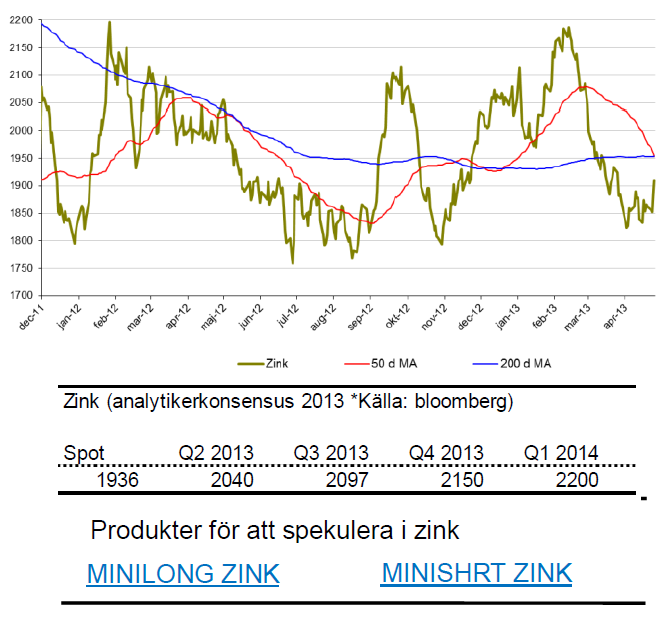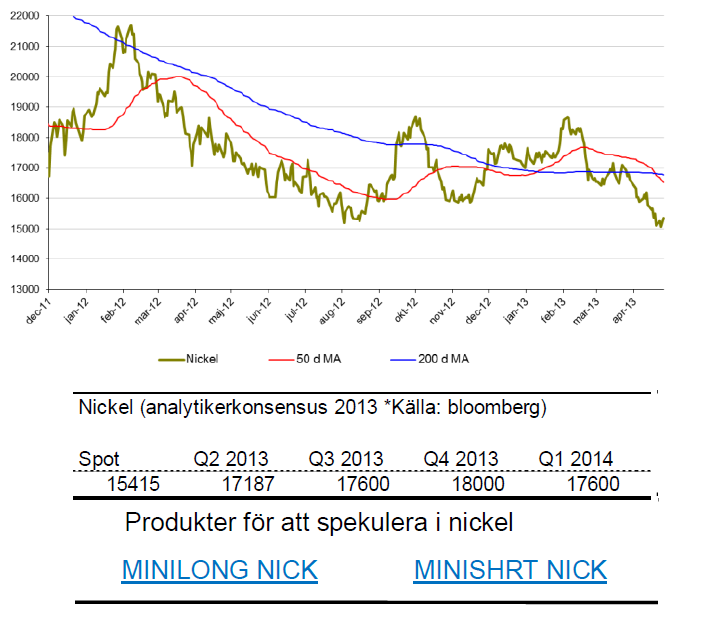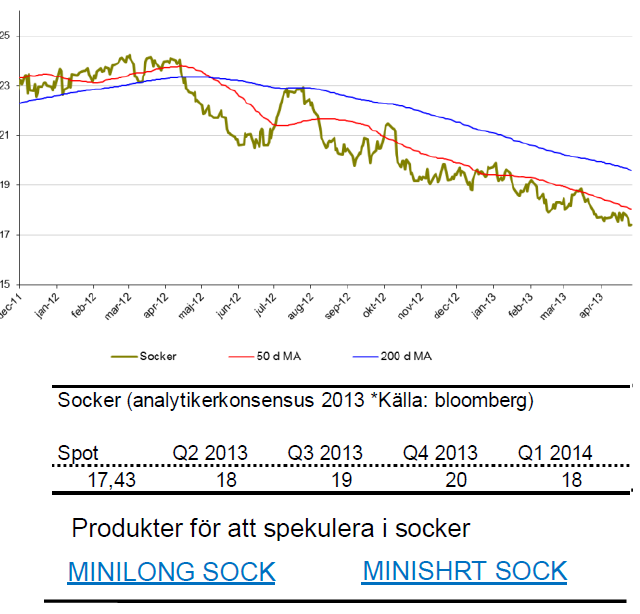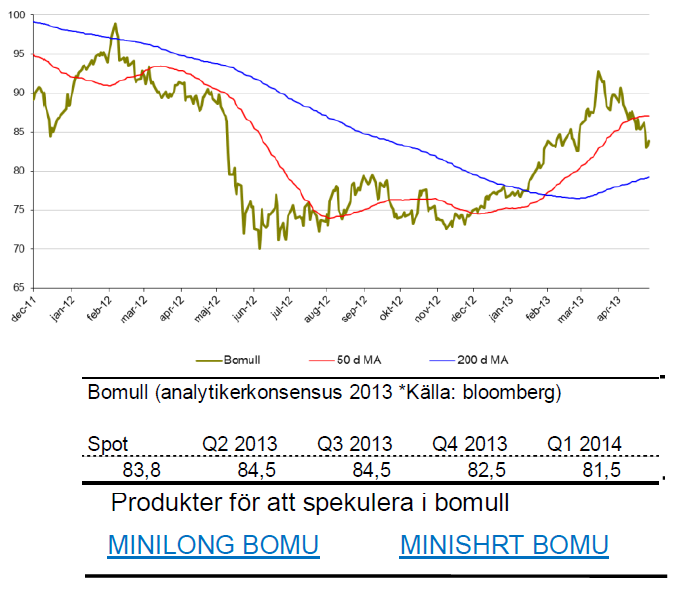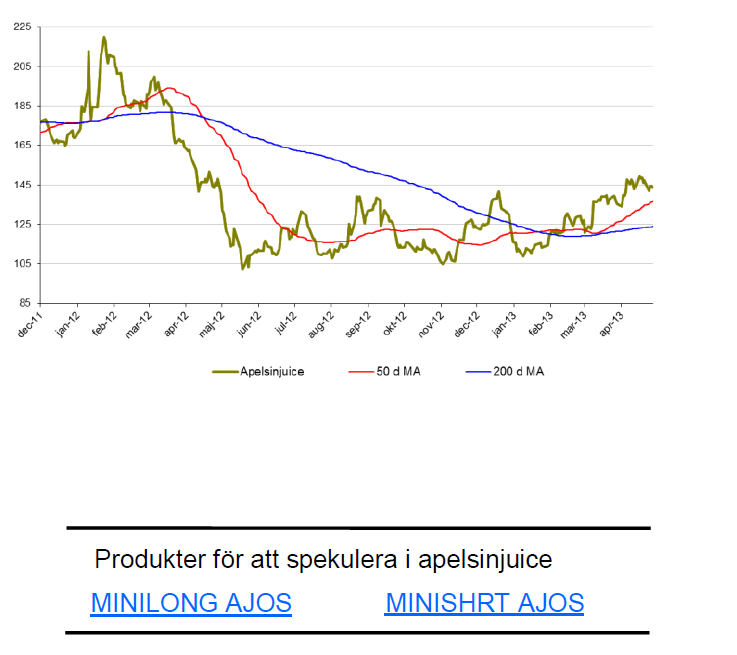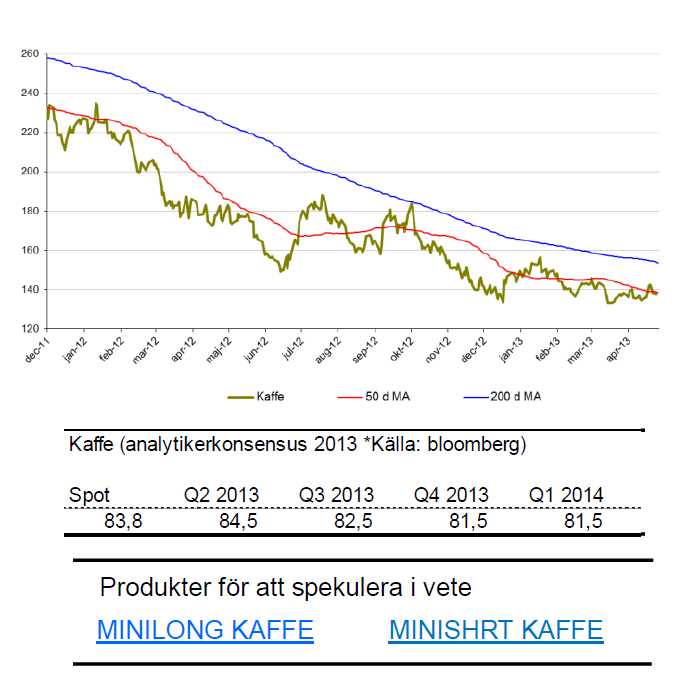Analys
SIP Nordic – Råvaruguiden – maj 2013

 Guld, olja och råvarubolag
Guld, olja och råvarubolag
Som författare av ett månatligt råvarubrev vore det närmast kriminellt att inte kommentera guldets ras och återhämtning(?) i april. Det har dock hänt andra spännande saker som bör nämnas.
Efter det kraftiga raset för två veckor sedan, det största nedstället på 30 år har säljarna lugnat ned sig. Guldet har de senaste 9 dagarna haft den största 9 dagarsuppgången på två år. Uppgången har återtagit nästan hälften av raset i april.
200 dagars medelvärde börjar nu peka nedåt och den stora frågan är nu om det 9 senaste dagarnas uppgång var en rekyl i en nedgång eller en början på en uppgång. Den senaste veckans uppgång är mer stabil än raset i mitten av april vilket är sunt för en fortsatt uppgång.
Brent och WTI nära varandra
Världspriset på olja har likt guldet också haft en spännande månad. Störst stryk har Brent tagit. Skillnaden i pris mellan de två mest handlade oljorna brent och WTI är nu det lägsta på 18 månader. Det kliar lite i fingrarna på att fortsatt spekulera i att prisskillnaden krymper ytterligare. Historiskt sett har WTI prissats dyrare än brent. Sedan 2008 är det dock den omvända relationen som gäller.
Nya råvarubolag
När oljepriset sjunker påverkar det priset på ett olje-relaterat bolag till viss del. Sedan tidigare är det möjligt att handla Africa Oil, BP och Lundin Petroleum med RBS Mini Futures. Nu breddar RBS utbudet och lanserar Mini Futures med Gazprom, Rosneft Oil, Petrobras och Lukoil som underliggande.
Alexander Frick
Råvaror – Energi
Brent olja
- Likt guld har olja svängt kraftigt under april. Efter ett stort ras har brent återhämtat sig något och handlas återigen över $100.
- Under april har brent tappat 6,5 % och är för året ned drygt 6,5 %.
- OPEC-nationerna har en agenda att hålla oljepriset över $100 och drar nu ned på produktionen. Sett utifrån den senaste veckans uppgång verkar detta vara en fungerande taktik.
- Oroligheter i mellanöstern kan fortsatt trycka priset uppåt.
- Prisskillnaden mellan brent och WTI är den lägsta på nästan 18 månader.
Naturgas
- Naturgas fortsätter att gå starkt. Under april är naturgas upp 6 % vilket gör att årets uppgång summeras till knappt 23 %.
- Naturgas har nu kämpat sig över den viktiga nivån kring $4 och den positiva trenden ser stark ut.
- Spekulanter ligger i övervikt i långa kontrakt och lagren ser låga ut vilket talar för en fortsatt uppgång.
Råvaror – Metaller
Guld
- Guld rasade kraftigt i april men har återhämtat hälften av fallet.
- Under april är guld ned 8 %. För året är guld ned 11 % vilket gör att chansen för ett trettonde positivt år ser svårt ut.
- Många spekulerar i vad som orsakade fallet. Inget tydligt svar verkar ges.
- Guld måste nog jobba sig upp mot $1550 innan en lång position är intressant. På nedsidan bevakas $1350-1400.
- Guld har under året påverkats av att riskaptiten ökar samtidigt som den amerikanska ekonomin ser starkare ut.
- Samtidigt fortsätter stimulanerna från FED och USD ser svag ut.
Silver
- Silver följer självklart med sin storbror guld. Återhämtningen har dock inte varit lika stark. Kanske finns en bra chans för att skala in sig för uppgång(?).
- Under april är silver ned 14 %. För året ned 19 %.
- Likt guld har silver straffats de fyra första månaderna av en större riskaptit och tecken på en starkare amerikansk ekonomi.
Platina
- Platina följer till stor del guld. Ned 5 % i april och 4,5 % för året.
- Platina, som är en mer använd ädelmetall handlas återigen till ett dyrare pris än guld.
- Motståndszon runt 1550$ är intressant att bevaka.
Koppar
- Trots en rekyl uppåt befinner sig koppar i en negativ trend. För året är koppar ned 11,5 % varav 6 % kom i april.
- Lagren av koppar är det största på nästan 10 år samtidigt som fler och fler spekulanter köper korta positioner.
- Positiv konsumtionsstatistik från Kina hjälper även föga eftersom lagren är så höga.
Zink
- Zinkpriset har kämpat på bra i april och är knappt förändrat i april. För året är dock zink ned knappa 10 %.
- Zink handlas snart i regionen kring en rad stöd (1820$). Rekyler där kan vara intressanta att bevaka.
- Ett s.k. dödskors, där 50 dagars medelvärde korsar 200 dagars medelvärde uppifrån sker snart vilket kan tyda på en fortsatt nedgång.
Nickel
- Nickel är för året ned drygt 10,5 %.
- Under april tappade nickel nästan 8 %.
- Nickel presterade sämst av alla basmetaller under 2012. Slutsiffran blev -8 % för 2012.
- Nickelmarknaden är fortsatt mättad med ökande lager.
- Många stora projekt inom nickelproduktion är redan finansierade och irreversibla vilket kommer att öka tillgången av nickel ytterligare.
Råvaror – Jordbruk
Socker
- Sockers kräftgång fortsätter. Sedan oktober förra året är sockerpriset ned 20 %.
- För året är sockerpriset ned drygt 10 % varav 2 % av nedgången kom i april.
- En anledning till det fortsatta prisfallet är att nuvarande nivåer inte motiverar sockerproduktion. Andra grödor eller etanol ses som mer attraktiva.
Bomull
- Efter en stark start på året backade bomull knappt 5 % under april.
- För året är priset på bomull upp 12 %.
- Sedan november 2012 är priset på bomull upp 21 %.
Majs
- I april föll priset på majs med 6 %.
- Sedan förra årets extremtorka har majs legat i en negativ trend.
- Det kalla och torra vädret har gjort att majssådden kommit igång senare än väntat.
- Stora skördar väntas dock och vädret ser ut att bli bättre.
- Följ således majs med försiktighet.
Vete
- Vete är i princip oförändrat i april
- Försiktighet gäller även här.
- För året är vete ned 5 %.
- Det kalla och torra vädret har gjort att vetesådden kommit igång senare än väntat.
- Stora skördar väntas dock och vädret ser ut att bli bättre.
Apelsinjuice
- Vi har länge bevakat apelsinjuice i Tradingklubben.
- Den viktiga nivån kring 143$ testades och bröts men nu handlas apelsinjuice återigen under denna nivå.
- För året är apelsinjuice upp 9,1 %.
- Priset på apelsinjuice är fortfarande 80 % högre än botten 2009. Fallhöjden är således hög. Mycket hög.
Kaffe
- Kaffe ligger fortfarande i en långsiktigt nedåtgående trend.
- För året är kaffe ned 9 % varav 2 % av nedgången kommit i april.
- Det är ökade lager som driver priset nedåt.
- Viktigt stödområde kring 135-138$.
[box]Denna uppdatering är producerat av SIP Nordic och publiceras i samarbete och med tillstånd på Råvarumarknaden.se[/box]
Ansvarsbegränsning
Detta produktblad utgör endast marknadsföring och har sammanställts av SIP Nordic Fondkommission AB.
Innehållet ger inte fullständig information avseende det finansiella instrumentet. Investerare uppmanas att del av prospekt och slutliga villkor, vilka finns tillgängliga på: www.rbsbank.se/markets, innan ett investeringsbeslut tas.
Förekommande exempel är simulerade och baseras på SIP Nordics egna beräkningar och antaganden, en person som använder andra data eller antaganden kan nå andra resultat. Administrativa avgifter och transaktionsavgifter påverkar den faktiska avkastningen.
Analys
Brent crude set to dip its feet into the high $50ies/b this week

Parts of the Brent crude curve dipping into the high $50ies/b. Brent crude fell 2.3% over the week to Friday. It closed the week at $61.29/b, a slight gain on the day, but also traded to a low of $60.14/b that same day and just barely avoided trading into the $50ies/b. This morning it is risk-on in equities which seems to help industrial metals a little higher. But no such luck for oil. It is down 0.8% at $60.8/b. This week looks set for Brent crude to dip its feet in the $50ies/b. The Brent 3mth contract actually traded into the high $50ies/b on Friday.

The front-end backwardation has been on a weakening foot and is now about to fully disappear. The lowest point of the crude oil curve has also moved steadily lower and lower and its discount to the 5yr contract is now $6.8/b. A solid contango. The Brent 3mth contract did actually dip into the $50ies/b intraday on Friday when it traded to a low point of $59.93/b.
More weakness to come as lots of oil at sea comes to ports. Mid-East OPEC countries have boosted exports along with lower post summer consumption and higher production. The result is highly visibly in oil at sea which increased by 17 mb to 1,311 mb over the week to Sunday. Up 185 mb since mid-August. On its way to discharge at a port somewhere over the coming month or two.
Don’t forget that the oil market path ahead is all down to OPEC+. Remember that what is playing out in the oil market now is all by design by OPEC+. The group has decided that the unwind of the voluntary cuts is what it wants to do. In a combination of meeting demand from consumers as well as taking back market share. But we need to remember that how this plays out going forward is all at the mercy of what OPEC+ decides to do. It will halt the unwinding at some point. It will revert to cuts instead of unwind at some point.
A few months with Brent at $55/b and 40-50 US shale oil rigs kicked out may be what is needed. We think OPEC+ needs to see the exit of another 40-50 drilling rigs in the US shale oil patches to set US shale oil production on a path to of a 1 mb/d year on year decline Dec-25 to Dec-26. We are not there yet. But a 2-3 months period with Brent crude averaging $55/b would probably do it.
Oil on water increased 17 mb over the week to Sunday while oil in transit increased by 23 mb. So less oil was standing still. More was moving.

Crude oil floating storage (stationary more than 7 days). Down 11 mb over week to Sunday

The lowest point of the Brent crude oil curve versus the 5yr contract. Weakest so far this year.

Crude oil 1mth to 3mth time-spreads. Dubai held out strongly through summer, but then that center of strength fell apart in late September and has been leading weakness in crude curves lower since then.

Analys
Crude oil soon coming to a port near you

Rebounding along with most markets. But concerns over solidity of Gaza peace may also contribute. Brent crude fell 0.8% yesterday to $61.91/b and its lowest close since May this year. This morning it is bouncing up 0.9% to $62.5/b along with a softer USD amid positive sentiment with both equities and industrial metals moving higher. Concerns that the peace in Gaza may be less solid than what one might hope for also yields some support to Brent. Bets on tech stocks are rebounding, defying fears of trade war. Money moving back into markets. Gold continues upwards its strong trend and a softer dollar helps it higher today as well.

US crude & products probably rose 5.6 mb last week (API) versus a normal seasonal decline of 2.4 mb. The US API last night partial and thus indicative data for US oil inventories. Their data indicates that US crude stocks rose 7.4 mb last week, gasoline stocks rose 3.0 mb while Distillate stocks fell 4.8 mb. Altogether an increase in commercial crude and product stocks of 5.6 mb. Commercial US crude and product stocks normally decline by 2.4 mb this time of year. So seasonally adjusted the US inventories rose 8 mb last week according to the indicative numbers by the API. That is a lot. Also, the counter seasonal trend of rising stocks versus normally declining stocks this time of year looks on a solid pace of continuation. If the API is correct then total US crude and product stocks would stand 41 mb higher than one year ago and 6 mb higher than the 2015-19 average. And if we combine this with our knowledge of a sharp increase in production and exports by OPEC(+) and a large increase in oil at sea, then the current trend in US oil inventories looks set to continue. So higher stocks and lower crude oil prices until OPEC(+) switch to cuts. Actual US oil inventory data today at 18:00 CET.
US commercial crude and product stocks rising to 1293 mb in week 41 if last nights indicative numbers from API are correct.

Crude oil soon coming to a port near you. OPEC has lifted production sharply higher this autumn. At the same time demand for oil in the Middle-East has fallen as we have moved out of summer heat and crude oil burn for power for air-conditioning. The Middle-East oil producers have thus been able to lift exports higher on both accounts. Crude oil and condensates on water has shot up by 177 mb since mid-August. This oil is now on its way to ports around the world. And when they arrive, it will likely help to lift stocks onshore higher. That is probably when we will lose the last bit of front-end backwardation the the crude oil curves. That will help to drive the front-month Brent crude oil price down to the $60/b line and revisit the high $50ies/b. Then the eyes will be all back on OPEC+ when they meet in early November and then again in early December.
Crude oil and condensates at sea have moved straight up by 177 mb since mid-August as OPEC(+) has produced more, consumed less and exported more.

Analys
The Mid-East anchor dragging crude oil lower

When it starts to move lower it moves rather quickly. Gaza, China, IEA. Brent crude is down 2.1% today to $62/b after having traded as high as $66.58/b last Thursday and above $70/b in late September. The sell-off follows the truce/peace in Gaze, a flareup in US-China trade and yet another bearish oil outlook from the IEA.

A lasting peace in Gaze could drive crude oil at sea to onshore stocks. A lasting peace in Gaza would probably calm down the Houthis and thus allow more normal shipments of crude oil to sail through the Suez Canal, the Red Sea and out through the Bab-el-Mandeb Strait. Crude oil at sea has risen from 48 mb in April to now 91 mb versus a pre-Covid normal of about 50-60 mb. The rise to 91 mb is probably the result of crude sailing around Africa to be shot to pieces by the Houthis. If sailings were to normalize through the Suez Canal, then it could free up some 40 mb in transit at sea moving onshore into stocks.
The US-China trade conflict is of course bearish for demand if it continues.
Bearish IEA yet again. Getting closer to 2026. Credibility rises. We expect OPEC to cut end of 2025. The bearish monthly report from the IEA is what it is, but the closer we get to 2026, the more likely the IEA is of being ball-park right in its outlook. In its monthly report today the IEA estimates that the need for crude oil from OPEC in 2026 will be 25.4 mb/d versus production by the group in September of 29.1 mb/d. The group thus needs to do some serious cutting at the end of 2025 if it wants to keep the market balanced and avoid inventories from skyrocketing. Given that IEA is correct that is. We do however expect OPEC to implement cuts to avoid a large increase in inventories in Q1-26. The group will probably revert to cuts either at its early December meeting when they discuss production for January or in early January when they discuss production for February. The oil price will likely head yet lower until the group reverts to cuts.
Dubai: The Mid-East anchor dragging crude oil lower. Surplus emerging in Mid-East pricing. Crude oil prices held surprisingly strong all through the summer. A sign and a key source of that strength came from the strength in the front-end backwardation of the Dubai crude oil curve. It held out strong from mid-June and all until late September with an average 1-3mth time-spread premium of $1.8/b from mid-June to end of September. The 1-3mth time-spreads for Brent and WTI however were in steady deterioration from late June while their flat prices probably were held up by the strength coming from the Persian Gulf. Then in late September the strength in the Dubai curve suddenly collapsed. Since the start of October it has been weaker than both the Brent and the WTI curves. The Dubai 1-3mth time-spread now only stands at $0.25/b. The Middle East is now exporting more as it is producing more and also consuming less following elevated summer crude burn for power (Aircon) etc.
The only bear-element missing is a sudden and solid rise in OECD stocks. The only thing that is missing for the bear-case everyone have been waiting for is a solid, visible rise in OECD stocks in general and US oil stocks specifically. So watch out for US API indications tomorrow and official US oil inventories on Thursday.
No sign of any kind of fire-sale of oil from Saudi Arabia yet. To what we can see, Saudi Arabia is not at all struggling to sell its oil. It only lowered its Official Selling Prices (OSPs) to Asia marginally for November. A surplus market + Saudi determination to sell its oil to the market would normally lead to a sharp lowering of Saudi OSPs to Asia. Not yet at least and not for November.
The 5yr contract close to fixed at $68/b. Of importance with respect to how far down oil can/will go. When the oil market moves into a surplus then the spot price starts to trade in a large discount to the 5yr contract. Typically $10-15/b below the 5yr contract on average in bear-years (2009, 2015, 2016, 2020). But the 5yr contract is usually pulled lower as well thus making this approach a moving target. But the 5yr contract price has now been rock solidly been pegged to $68/b since 2022. And in the 2022 bull-year (Brent spot average $99/b), the 5yr contract only went to $72/b on average. If we assume that the same goes for the downside and that 2026 is a bear-year then the 5yr goes to $64/b while the spot is trading at a $10-15/b discount to that. That would imply an average spot price next year of $49-54/b. But that is if OPEC doesn’t revert to cuts and instead keeps production flowing. We think OPEC(+) will trim/cut production as needed into 2026 to prevent a huge build-up in global oil stocks and a crash in prices. But for now we are still heading lower. Into the $50ies/b.
-

 Nyheter4 veckor sedan
Nyheter4 veckor sedanOPEC+ missar produktionsmål, stöder oljepriserna
-

 Nyheter4 veckor sedan
Nyheter4 veckor sedanEtt samtal om guld, olja, fjärrvärme och förnybar energi
-

 Nyheter2 veckor sedan
Nyheter2 veckor sedanGoldman Sachs höjer prognosen för guld, tror priset når 4900 USD
-

 Nyheter3 veckor sedan
Nyheter3 veckor sedanBlykalla och amerikanska Oklo inleder ett samarbete
-

 Nyheter3 veckor sedan
Nyheter3 veckor sedanGuld nära 4000 USD och silver 50 USD, därför kan de fortsätta stiga
-

 Analys4 veckor sedan
Analys4 veckor sedanAre Ukraine’s attacks on Russian energy infrastructure working?
-

 Nyheter4 veckor sedan
Nyheter4 veckor sedanGuldpriset uppe på nya höjder, nu 3750 USD
-

 Nyheter3 veckor sedan
Nyheter3 veckor sedanEtt samtal om guld, olja, koppar och stål


